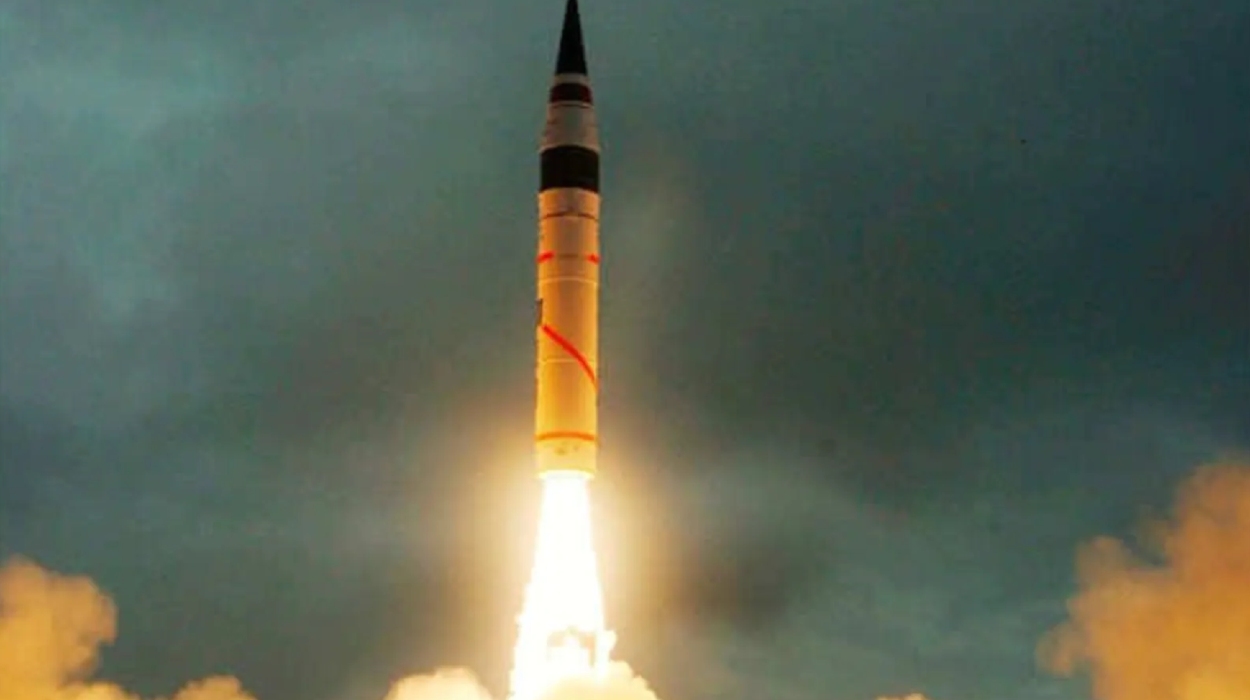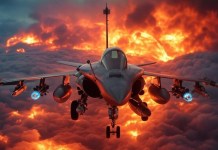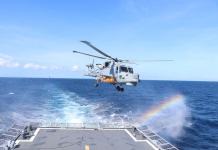In a significant escalation in the ongoing Ukraine War, Russia launched a ballistic missile using Multiple Independent Re-entry Vehicles (MIRVs) against a Ukrainian city on November 21. This marks the first-ever use of MIRV in combat and has sent shockwaves across the world.
The Ukrainian Air Force claimed on November 21 that the Russian forces fired an Intercontinental Ballistic Missile (ICBM) on Dnipro, a city in Eastern Ukraine. Soon after, a spate of conflicting claims emerged, with some Western officials telling the media that it was an Intermediate-Range Ballistic Missile (IRBM) instead.
Finally, putting all speculations to rest, Russian President Vladimir Putin revealed to the media that the missile used in the attack was an entirely new weapon—a medium-range “hypersonic” missile—‘Oreshnik.’
The attack set in motion several claims and counterclaims by officials and experts who expressed their shock and alarm at the missile attack. However, one common denominator among all the claims was that the ballistic missile had Multiple Independent Re-entry Vehicles (MIRV).
These claims were based on videos posted to social media showing the missile breaking into six warheads.
More than the missile itself, the use of MIRV has rattled military watchers and nuclear experts. Hans Kristensen, the director of the Nuclear Information Project at the Federation of American Scientists, said, “To my knowledge, yes, it’s the first time MIRV has been used in combat.” In the attack’s aftermath, military analysts surmised that Moscow’s deployment of this new missile with MIRV was akin to a warning.
Indian military analyst and retired IAF fighter pilot called it a retaliation sans escalation!
Why Are MIRVs So Dangerous?
The concept of MIRV is nearly always connected to, but not necessarily restricted to, intercontinental ballistic missiles that carry thermonuclear weapons, which is why the initial reports suggested the use of an ICBM in the attack.
Even though the warheads launched on the Ukrainian city of Dnipro were not nuclear, shooting them down would have been a daunting task for Kyiv despite claiming to have shot down multiple hypersonic Kinzhal missiles.
Typically, with single-warhead missiles, one missile is launched for each target. In contrast, a multiple independently targetable re-entry vehicle (MIRV) is a type of exoatmospheric ballistic missile with many warheads, all of which can be directed at different targets.
MIRVs are loathed (and loved) for the same reason: they can penetrate well-defended airspaces and overwhelm the defense systems of adversaries.
MIRVs reduce the effectiveness of AD systems from a military and economic standpoint because it would be very expensive to maintain a viable defense against MIRVs, needing multiple defensive missiles for every offensive one.
Moreover, the military launching the strike can use some decoy re-entry vehicles with real warheads. This would reduce the possibility of real warheads being intercepted before reaching their targets.
MIRV is an extremely complex technology that requires large missiles, small warheads, accurate navigation, and a mechanism that fires warheads sequentially while in flight—all highly developed technologies.

The use of MIRV could be detrimental if the ICBM or IRBM ballistic missile is equipped with a nuclear payload. Scientists have condemned the use of a technology that enables the discharge of multiple warheads at a time when nations around the world are rallying for nuclear non-proliferation and reducing the size of their nuclear weapons.
In the nuclear age, ICBMs have served as the foundation for deterrence by providing “mutually assured destruction,” or MAD. It is believed that if even a small number of missiles survive a nuclear first strike, the enemy will still have enough firepower in its arsenal to destroy several of the aggressor’s major cities, guaranteeing that neither side can avoid the repercussions of nuclear strikes. This idea was meant to deter a first strike. However, MIRVs act as an antidote to that idea.
Analysts, including Kristensen, contend that MIRVed missiles would encourage a first strike rather than prevent it. In a study released in March, Kristensen and co-author Matt Korda of the Federation of American Scientists wrote that due to their extremely destructive potential, MIRVs can be used as both first-strike weapons and targets based on the “use them or lose them” principle.
A first strike using MIRVs would decapitate the target country. However, their lethality is the reason they could be the object of a first strike.
A recent post from the Union of Concerned Scientists, a nonprofit science advocacy group headquartered in the US, claims that this creates a situation where people are motivated to act first in an emergency. If a first-strike attack were to destroy a nation’s MIRVed missiles, “that nation’s ability to retaliate would be disproportionately damaged.”
When India conducted the MIRV test in March this year, Kristensen expressed his disappointment, saying: “US/Russian decision to walk away from START II MIRV ban is looking less wise as more countries try to get MIRV.”

The Concern Surrounding MIRVs Is Growing
The United States was the first to develop the technology, deploying an MIRVed intercontinental ballistic missile in 1970 and a MIRVed Submarine-launched Ballistic Missile (SLBM) the following year.
The former Soviet Union also developed its own MIRV technology. Other countries with nuclear weapons, such as the UK, France, China, and India, have also demonstrated MIRV technology.
Pakistan has also claimed that its Ababeel surface-to-surface medium-range ballistic missile (MRBM) is capable of carrying MIRVs. However, some experts have expressed doubts over Islamabad’s claims. North Korea has also claimed successful testing of MIRV, but the United States remains skeptical.
On March 11, India successfully test-fired a long-range ballistic missile, Agni-V, with Multiple Independently Targetable Re-entry Vehicle (MIRV) technology, entering the exclusive group of countries with MIRV technology. India has a “no first use” policy via a vis nuclear weapons. However, the MIRV testing by India caused alarm about a potential “first-strike” instrument in New Delhi’s inventory.
Kristensen had written about the perils of India possessing MIRV in an article in 2021: “If either country believed that India could potentially conduct a decapitating or significant first strike against Pakistan, a serious crisis could potentially go nuclear with little warning. Indian missiles with MIRVs would become more important targets for an adversary to destroy before they could be launched to reduce the damage India could inflict. Additionally, India’s MIRVs might prompt Indian decision-makers to try and pre-emptively disarm Pakistan in a crisis.”
Some other assessments stated that the test aimed to develop capability against China. The Bulletin for Atomic Scientists wrote, “India’s test of MIRV technology on the Agni-V missile shows that it is making qualitative technological advances in its ability to target China.” However, some Indian scholars who specialize in nuclear missiles stated in no uncertain terms that the MIRV technology was purportedly tested by India to strengthen the no-first-use doctrine. You can read a detailed EurAsian Times report here.

North Korea is another country whose MIRV technology has come under the scanner recently. Earlier this week, the top officer of the US in the Pacific region, US Navy Adm. Samuel Paparo, said the US military has not received any concrete proof about North Korea successfully testing a re-entry vehicle that can carry a nuclear weapon back down to Earth through the atmosphere.
“All will have been aware by now that North Korea tested its largest ballistic missile, having reached an apogee of over 7,000 kilometers [approximately 4,349.5 miles], portending a capability that will have the ability to range the entire continental United States,” Adm. Paparo said at an open event at the Brookings Institution. He was referring to the test launch of North Korea’s Hwasong-19 intercontinental ballistic missile (ICBM), which is said to be its longest-ranged design so far. North Korean officials reported that the missile’s maximum height was 7,687.5 kilometers or roughly 4776.8 miles.
The US officer’s comments are significant because North Korea announced in June 2024 that it had successfully tested a multi-warhead missile. At the time, the state-run KCNA quoted the Missile Administration as saying that weapon testing had reached a full-scale phase to strengthen North Korea’s missile capabilities and improve missile technologies. North Korean leader Kim Jong Un had listed a multi-warhead missile on his wish list during a ruling party conference in early 2021.
This, however, is bad news for proponents of a world free of nukes. In their joint study published in March, Kristensen and Korda discussed the perils of the growing MIRV club, referring to it as “an emerging nuclear arms race” and “a sign of a larger worrisome trend in worldwide nuclear arsenals.” According to their argument, adding more MIRV warheads to other nations’ arsenals would drastically reduce crisis stability by incentivizing leaders to launch their nuclear weapons quickly in a crisis.
“A world in which nearly all nuclear-armed countries deploy significant MIRV capability looks far more dangerous than our current geostrategic environment,” they said. The Russian use of MIRV—the first ever in combat—appears to have reinforced that thinking.
- Contact the author at sakshi.tiwari9555 (at) gmail.com
- Follow EurAsian Times on Google News




